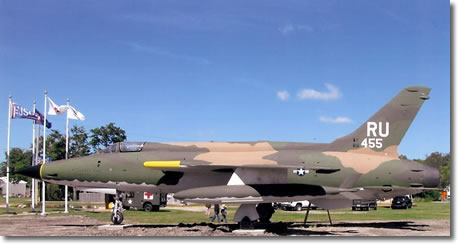F-105 Thunder chief

At the on start of the cold war, the United
States needed a very fast plane that could deliver a nuclear strike.
Republic aircraft company at Farmingdale, New York Designed and
Delivered America�s biggest and baddest bomber in 1961. This plane
was designed and built with one purpose in mind.
She was to be tactical air commands primary nuclear bomber.
It was given the designation of F-105.
However, in 1961 the Vietnam War was heating
up. By 1965 the F105�s
primary objective was changed and her bomb bay was converted to a
600 gal gas tank. Nuclear bombs were replaced with iron bombs and
her payload was increased to 14,500 lbs. At first the F-105 was
expensive to maintain and fly.
It needed 150 hours of maintenance for every hour of flight
time. Spare parts were
hard to come by.
Although it could fly at supersonic speed, it was heavy and not
meant for conventional warfare.
It had no bombsite so pilots had to dive bomb their targets.
Once loaded with bombs it had to be refueled shortly after takeoff. It landed with a rebounding thud which resulted in the pilots
nicknaming her �The Thud�
As more F-105's were made and tests run the
needed changes were made. Maintenance hours were reduced and parts
became available. By 13
Jan 65 the first strike mission took place in Vietnam. Five months
earlier on 14 Aug 64 she carried out her first combat mission.
Fighting off anti-aircraft artillery, MIGs and
surface to air missiles the F-105 served with distinction. Two F-105
pilots received the Medal of Honor.
Both pilots: Capt.
Merlyn H. Dethlefson and Capt. Leo K. Thorsness, served with
the United States Air Force.
Of the 833 F-105�s that were made; almost half were lost.
Depending on which reference book you look at the number lost
ranges from 382 to 395. At least 61 were lost because of operational
accidents.
Although residing at many Air Force Bases
stateside and overseas, this warbird had time in South East Asia
serving from 1968-1970 with the 355 tactical fighter wing located at
Takhli, Thailand. 455 survived combat in Vietnam and retired in 1981
with almost 5000 Flying hours in 1986. It was transferred to
Jackson, Mississippi where it stayed for the next 26 years. In 2010
it was transferred to Veterans Memorial Park in Dixon, Ill where it
sits among other distinguished artifacts.
Specifications of F-105 Thunderchief
Serial Number 60-455
-
Type -
F-105 with T-Stick Modification
-
Wingspan -
34' 11"
-
Length -
64' 5.3"
-
Height -
19' 8"
-
Empty Weight -
26,855 lbs
-
Max. Weight -
52,838 lbs
-
Powerplant -
Pratt & Whitney J75-P-19-W
-
Max Speed -
Mach 2
-
Service Ceiling -
48,500 feet
-
Rate of Climb -
38,5000 Feet per minute
-
Time to Altitude - 1.7
minutes to 35,000 feet
-
Max. Range -
2390 Miles
-
Crew -
1
PHOTO GALLERY
(Click on any
thumbnail picture to view a larger version)
#455 in Dixon
Reassembly and Paint
Prep
#455 In Mississippi
Preparing for
move to Illinois
#455 IN Mississippi
Taken by
professional Photographer & Scanned.
# 455 IN Texas
Historical photos
when Jet was Based in Texas (TH)
|











